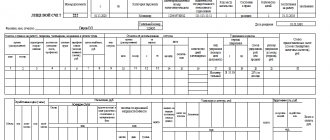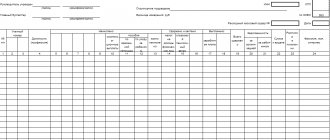Title page
At the top, you must indicate the details of the organization (name, OKPO code and structural unit in which the employee is registered). All other data relates to a specific person.
The tabular part includes the following information:
- Document number (assigned upon creation).
- Billing period. Starts from the date of hire. We leave the end date open.
- Personnel category. Here, as a rule, the following options are used: worker, specialist or manager.
- Personal data (full name, date of birth, TIN, SNILS, marital status and number of children). They can be taken from the employee’s personal card.
- Residence code. This refers to the OKTMO code.
The date of entry to work coincides with the beginning of the billing period, if it is decided to maintain the document from hiring to dismissal.
When is the T-54 form used?
Form T-54 is used to combine information about salary and vacation pay for each employee. This unified form consists of several tables, which sequentially indicate:
- employee name;
- his personnel number;
- date of birth;
- speciality;
- number of days or hours worked;
- duration and type of leave;
- period of incapacity;
- payments (total amount and breakdown by category);
- debt.
Personal accounts of T-54 employees are not mandatory for use; they should be used only if appropriate. They are convenient for large companies with several dozen or even hundreds of employees. Small firms, and especially individual entrepreneurs, do not need this form.
A separate card is created for each employee. This makes the work very labor-intensive if the organization has several hundred employees.
The forms are maintained throughout the year and are updated monthly with new information: who was on vacation, who took sick leave, who quit, and most importantly, how much money was accrued to each employee.
Personal account in form T-54
Document body
The personal account consists of several tables with continuous numbering of columns. The first of them (columns 1-8) is official information. It must be paid immediately upon employment.
In general, it is enough to transfer all the data in this part from the employment order. Let us explain in the fifth column - working conditions. This does not mean normal, dangerous or harmful, but the number of hours and days in the work week.
The following table (columns 9-16) contains information about holidays. They can also be taken from the corresponding orders. Here it is necessary to distinguish between periods: in columns 12 and 13 - the beginning and end of the working year in which the employee goes on vacation, in columns 14 and 15 - the beginning and end of the vacation itself. We calculate the number of calendar days based on dates (14) and (15).
The third table (columns 16-22) concerns deductions (what the employee did not receive) and contributions:
- Type of retention. Usually these are forced seizures based on writs of execution (by court decision) or orders from management (for example, to compensate for damages).
- Holding period. How long will it take to collect the total amount?
- Withholding amount. Debt under a writ of execution or damage caused.
- Retention amount. The amount that the employee will not receive this month (cannot exceed 50% of income).
The amount of benefits provided is the amount of tax deduction to which the employee is entitled.
The fourth table (columns 23-37) is an accounting of time worked and corresponding accruals. Here is a breakdown by month. Please note: columns 28-32 have two headings: the top one in words, the bottom one in code.
The same applies to columns 39-45 and 47-48 of the last table. It is necessary to enter the withheld taxes and summarize the amounts payable.
Build payment type codes
Table 3 – Filling out payment type codes
| Data_Fakt | Vall | Summ_Vall | Cost | Summ_Cost | Summ_S_Vall | Summ_S_Cost | D_Cost |
| 02.06.2001 | |||||||
| 28.11.2002 | |||||||
| 07.01.2003 | |||||||
| 12.08.2009 | |||||||
| 01.02.2009 | |||||||
| 02.02.2009 | |||||||
| 01.02.2009 |
2.4 Describe the list of primary documents and the possibility of changing them in the document “Employee’s Personal Card”
All financial and economic operations of the enterprise, including payroll, must be documented and justified.
The list of primary documents for recording the use of working time and settlements with personnel (wages) and the forms of these documents were approved by Resolution of the State Statistics Committee of Russia dated January 5, 2004 No. 1.
The primary accounting of the number of personnel of the organization is carried out on the basis of the following documents:
— order (instruction) on hiring (Form No. T-1), which is the basis for hiring. The person responsible for accounting for the personnel of the organization’s employees, in accordance with this order, fills out a personal card for each newly hired employee, makes an entry in the work book, and opens a personal account in the accounting department;
— personal card (form No. T-2), which is filled out for each employee. It contains general information about the employee (last name, first name, patronymic, date and place of birth, education, etc.), information about military registration, appointment and transfer, advanced training, retraining, leave and other additional information;
— order (instruction) on transfer to another job (Form No. T-5), which is used when registering the transfer of an employee from one structural unit to another;
— order (instruction) on granting leave (Form No. T-6), which is used to formalize annual and other types of leave provided to employees in accordance with the Labor Code of the Russian Federation, current legislative acts and regulations, collective agreements and schedules vacations;
— order (instruction) on termination (termination) of an employment contract with an employee (dismissal) (Form No. T-8), which is used when registering the dismissal of employees. Based on it, the accounting department makes settlements with the employee;
— other unified forms To record working hours and pay wages to personnel, the following unified forms of primary documentation are used:
— a timesheet for recording working hours and calculating wages (Form No. T-12) and a timesheet for recording working hours (Form No. T-13), which records the use of the working time of all employees in a given organization. The report card in form No. T-13 is used in conditions of automated data processing. Form No. T-12 is filled out manually by an accounting employee. The symbols of worked and unworked time presented on the title page of form No. T-12 are also used when filling out form No. T-13. These timesheets are compiled in one copy and submitted to the accounting department. They allow not only to take into account the time worked by all categories of employees, but also to monitor compliance by workers and employees with the established work schedule. Based on the timesheets, wages are calculated, statistical reporting on labor is compiled. The use of working time is recorded in timesheets either by the method of continuous (daily) registration of appearances and absences for work, or by registering only deviations (no-shows, tardiness, etc.). d.). Notes on the reasons for absence from work or for part-time work, for working overtime and other deviations from the established work schedule must be entered into the timesheet only on the basis of documents (certificates of incapacity for work, certificates, orders for the performance of state or public duties and etc.).
This is interesting: Regulations on the surgical department of a hospital sample
Accounting for time spent on overtime work can also be carried out on the basis of lists of persons who performed this work. The lists are compiled and signed by the head of the structural unit. The overtime manager makes a note of the number of overtime hours actually worked. Based on lists with this mark, the data is entered into the timesheet. Downtime can also be taken into account in the timesheet. The relevant data is entered on the basis of downtime sheets issued by the head of the structural unit. The following forms of statements are used for the calculation and payment of wages.
— payroll statement (Form No. T-49), which is recommended for medium and small organizations. When compiling this form, it is permissible not to fill out other payroll and payroll statements;
— payroll (form No. T-51), which is used to calculate wages for all categories of workers. Recommended for use in large organizations;
— payroll (form No. T-53), which is used to record wage payments;
— personal account (forms No. T-54 and No. T-54a), which is filled out by an accountant for each employee on the basis of primary employment documents and which indicates the necessary information: last name, first name, patronymic; workshop, department of an organization; category of personnel; employee personnel number; number of children (to determine deductions when calculating personal income tax); Enrollment Date.
The personal account is filled out throughout the year, and all types of accruals and deductions made are reflected in it on a monthly basis. The data contained in the personal account is the basis for calculating average earnings when paying for vacations, accruals for sick leave, etc. The following year, a new personal account is opened for each employee.
The most important indicators reflecting labor costs are labor standards, which are established for workers in accordance with the achieved level of equipment, technology, organization of production and labor.
Labor legislation provides for the following types of labor standards:
— production rate — the amount of products that a worker (group of workers) of a certain qualification must produce per unit of working time,
- standard time - the amount of working time (in hours, minutes) that an employee (group of employees) of a certain qualification must spend on the production of a unit of product (work, service);
- service rate - the number of objects (equipment units, production areas, workplaces, etc.) that an employee (group of employees) must service per unit of time (per hour, working day, work shift, working month);
— headcount norm — the number of employees with the appropriate qualifications to perform a certain amount of work (production, management functions). Depending on the nature of production, various primary documents are used to record production output - piece work orders, route sheets, production reports, etc. In conditions of mass production, output is taken into account when accepting finished products. The output of each team member is established on the basis of output reports filled out by the foreman.
In mass production, output is taken into account using route sheets in combination with a report from the foreman or foreman, which records the acceptance of work (their volume) per shift. In individual or small-scale production, output is taken into account, as a rule, using piecework orders work. They are prescribed on the basis of technological maps. Work orders can be issued for one shift or for a longer period (up to one month), depending on the time required to complete the production task. After receiving the products from the workers, the foreman signs the work order and transfers it to the accounting department.
Bibliography
1. Andreeva V.I. Samples of documents in office work/ - M.: CJSC "Business School" Intel-Sintez", 2007.
2. Computer Science: Basic Course/Ed. S.V.Simonovich. - St. Petersburg: Peter, 2002. 400 s.
3. Kozharsky V.V., Sushkevich V.N. Accounting in enterprises and organizations: Proc. manual.- Mn.: PKF “Account”, 2005. p.127








